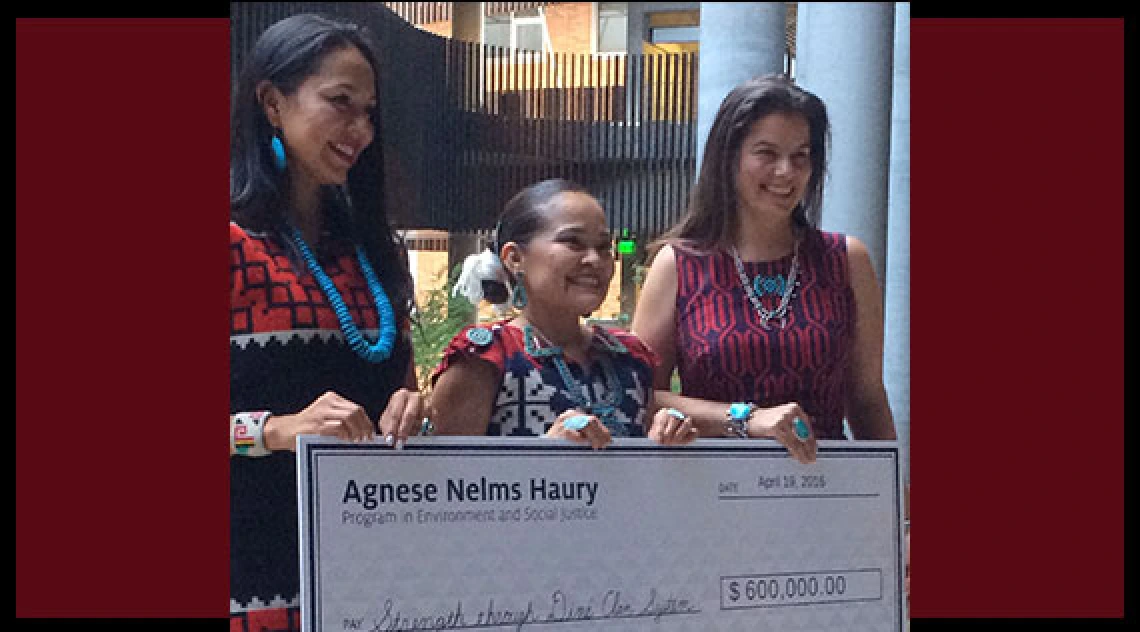UA SRP Gold King Mine Researchers Receive Inaugural Award in Agnese Nelms Haury Program Grant Challenge

 University of Arizona Superfund Research Program (UA SRP)’s rapid response efforts to the Gold King Mine spill benefited many lives touched by the event, and have now resulted in the first-time award of the Agnese Nelms Haury Challenge Grant. The Gold King Mine research project to be funded by the grant is led by UA SRP investigator, Dr. Karletta Chief, and collaborator, Dr. Paloma Beamer, and includes five partners: Tó Bei Nihi Dziil (Our strength comes from the water), Diné College, Navajo Nation Community Health Representative Program, Fort Lewis College and Northern Arizona University. The three-year, inaugural Agnese Helms Challenge Grant will provide $600,000 for the team’s project entitled, “K’é bee da’ahííníítą: Strength through the Diné (Navajo) clan system to respond to the Gold King Mine Spill.”
University of Arizona Superfund Research Program (UA SRP)’s rapid response efforts to the Gold King Mine spill benefited many lives touched by the event, and have now resulted in the first-time award of the Agnese Nelms Haury Challenge Grant. The Gold King Mine research project to be funded by the grant is led by UA SRP investigator, Dr. Karletta Chief, and collaborator, Dr. Paloma Beamer, and includes five partners: Tó Bei Nihi Dziil (Our strength comes from the water), Diné College, Navajo Nation Community Health Representative Program, Fort Lewis College and Northern Arizona University. The three-year, inaugural Agnese Helms Challenge Grant will provide $600,000 for the team’s project entitled, “K’é bee da’ahííníítą: Strength through the Diné (Navajo) clan system to respond to the Gold King Mine Spill.”
Finalists in the challenge were required to deliver a 10-minute presentation similar to a Tedx talk. The Challenge Grant presentations, which took place on April 19th, included three challenge-grant team finalists, each comprised of UA researchers partnered with local community groups and representing projects stemming from citizen science and community engagement efforts.
The Navajo team, represented on stage by Drs. Chief and Beamer (UA) and Janene Yazzie (Tó Bei Nihi Dziil), opened their talk with the following narrative: “Imagine waking up one morning to turn on the faucet only to see this yellow sickness coming from your spigot. This experience would be shocking! It would cause worry, fear and stress as you try to search for answers. If you can imagine that, you can imagine a fraction of the devastation experienced by Navajo communities who watched helplessly as their river turned yellow.” The presenters then talked about the extent of the impacts of the Gold King Mine spill to the Navajo people from both the practical and cultural perspectives. They discussed the loss of vital crops and emotional stress related to the role of the river in prayers, ceremony, and beliefs. To combat the systemic cultural issues brought to light by this isolated (although acute) incident, the team discussed the need for education and training. With funding received from the Agnese Haury Foundation, the team proposes to partner with tribal college students, environmental interns, and community health representatives to increase their capacity to respond to future spill and to help develop long-term solutions.
 After delivering their compelling presentation, the Chief and Beamer team was announced the winner of the $600,000 challenge grant. This grant will augment an $434,000 R21 award received earlier this year from the National Institute of Environmental Health Sciences, which assesses exposure levels and impacts to communities living down-stream from the spill. In response to the emotional experience of presenting on the Gold King Mine spill to a packed UA auditorium, and then winning the challenge grant award, Chief said, “It is an honor for our team to receive the inaugural Haury Challenge Grant and to continue the legacy of Agnese Nelms Haury in promoting social and environmental justice, particularly in knowing that Ms. Haury had a heart for Native American communities. Also, this project focuses on the environmental injustices facing the Diné Nation at large, as well as efforts to increase our resiliency to future spills and to work collaboratively with our Dine partners in addressing long-term impacts.”
After delivering their compelling presentation, the Chief and Beamer team was announced the winner of the $600,000 challenge grant. This grant will augment an $434,000 R21 award received earlier this year from the National Institute of Environmental Health Sciences, which assesses exposure levels and impacts to communities living down-stream from the spill. In response to the emotional experience of presenting on the Gold King Mine spill to a packed UA auditorium, and then winning the challenge grant award, Chief said, “It is an honor for our team to receive the inaugural Haury Challenge Grant and to continue the legacy of Agnese Nelms Haury in promoting social and environmental justice, particularly in knowing that Ms. Haury had a heart for Native American communities. Also, this project focuses on the environmental injustices facing the Diné Nation at large, as well as efforts to increase our resiliency to future spills and to work collaboratively with our Dine partners in addressing long-term impacts.”

